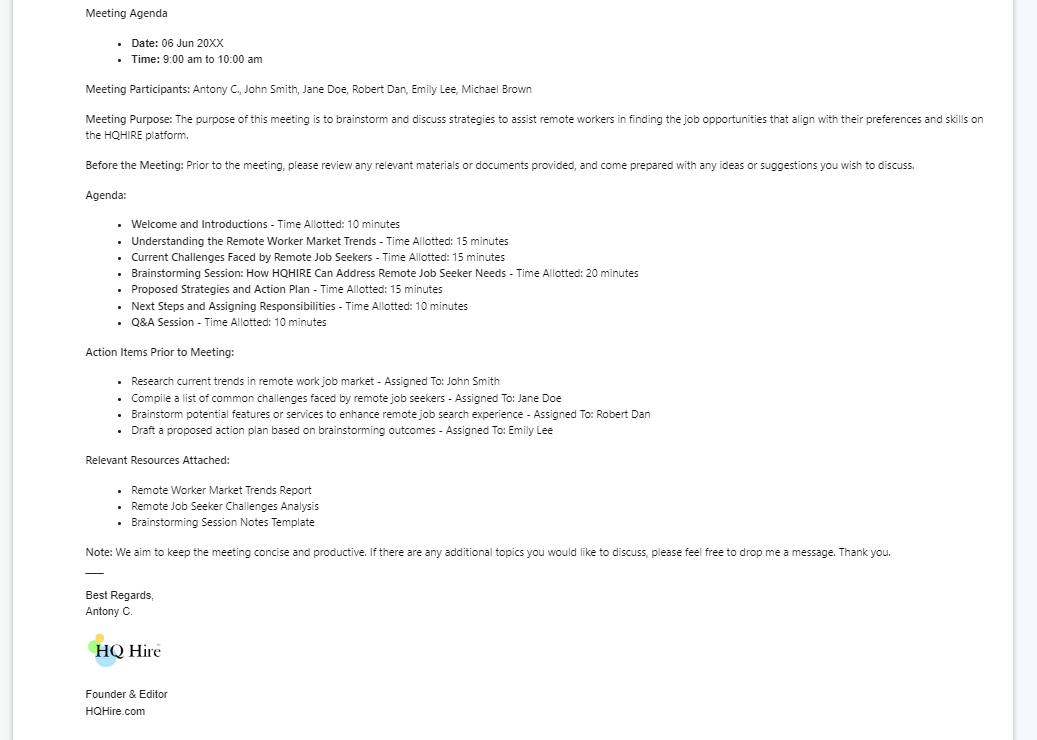Meetings offer an effective way to communicate with various stakeholders, however, most meetings, exactly 70% of all meetings are a waste of time, lacks focus and tend to overrun. Bad meetings are voted as the #1 productivity killer according to Microsoft, and the main reason is due to the lack of a meeting agenda.
Having a meeting agenda can help to shorten meeting, set clear meeting objectives, respect meeting participant’s time and create highly effective meeting regardless if you are meeting face-to-face or having an online meeting.
Key Takeaways
- Meeting agenda offers a clear focus, goals and objectives of the meeting which helps to shorten the meeting and make the meeting effective for all stakeholders.
- Meeting agenda should be customized according to the different types of meeting.
- Face-to-face meeting and online meeting, both requires a meeting agenda to ensure meeting productivity.
What is a Meeting Agenda?
Meeting agenda is a document send prior to a meeting designed to keep the conversation focused and on schedule for the upcoming meeting. Think of it as a detailed list outlining what will be discussed, who will lead each topic, and how long each segment will last so each participant will come prepared and will know what is to be expected of the meeting.
Here’s a simple structure for creating a meeting agenda:
- Clarify Objectives: Define the exact goals of your meeting. Specific aims guide the flow and prep work.
- Attach Purpose to Tasks: Ensure every agenda item has a clear purpose, reinforcing its relevance to the overarching objective.
- Outline Key Topics: Frame the main points as questions to stay engaged and directed towards the end goal.
- Time Allocation: Assign realistic time slots to each agenda item, valuing everyone’s time and keeping on track.
- Assign Roles: Designate facilitators for each part of the meeting to lead the discussion effectively.
Your meeting agenda sets the tone for the meeting, facilitates preparation, and help to respects each participants’ time. This document should be sent right after your participants have confirmed their attendance at least 3 days prior to the meeting.
How to Write Meeting Agenda?

Crafting a meeting agenda is crucial for efficient and productive team discussions. By following a structured plan, you ensure every team member knows what to expect and stays focused on the meeting’s goals.
Step 1: Establish The Type of Meeting
Prior to your meeting, you should identify the type of meeting you are planning as each type of meeting will have a different requirements and list of topics to be discussed.
- Status Update Meeting: Provides updates on project progress and addresses any challenges.
- Decision-Making Meeting: Discusses and makes critical business decisions.
- Brainstorming Session: Generates creative ideas and solutions for specific challenges.
- Problem-Solving Meeting: Identifies, analyzes, and resolves obstacles hindering progress.
- Planning Meeting: Outlines strategies, sets goals, and develops action plans.
- Training or Onboarding Meeting: Provides orientation and training for new team members.
- Team Building Meeting: Enhances teamwork, collaboration, and trust among team members.
- Review or Evaluation Meeting: Assesses past performance and identifies areas for improvement.
- Client or Stakeholder Meeting: Engages with clients or stakeholders to discuss updates and opportunities for collaboration.
Is it a team meeting, an executive session, or a brainstorming meeting?
Your agenda should reflect the meeting’s nature, setting the appropriate expectations for all participants.
Step 2: Clarify Meeting Objectives
Define clear objectives on why, and what this meeting is about. Make it clear what is the objective of the meeting and the expected outcome of the meeting.
What is the ultimate goal of this gathering? Whether it is to provide updates, collect insights, or make decisions, a clear purpose aligns the group’s efforts and contributes to the meeting’s productivity.
Step 3: Outline Key Topics For The Meeting
List the topics that need attention, ensuring they are relevant to all attendees. Outlining the key topics for the meeting helps to encourages active participation and keeps the discussion targeted.
With key topics listed, your participants will have a rough idea on what it is about and will come more prepared for the meeting, making the meeting more effective.
Choose only a tight selection of topics that directly contribute to achieving the meeting’s objectives, avoid putting too many topics to prevent confusion.
Step 4: Allocate Time and Prioritize Agenda Items
Assign a specific timeframe to each topic to maintain a steady pace and cover all necessary subjects. Time allocation keeps the meeting concise and respects everyone’s time.
Your participants will have a rough idea on how deep they are going to discuss on each of the topic and the priority of importance for the topic during the meeting.
Consider adding a simple priority table for prioritizing agenda items:
| Priority | Topic | Time Allocation |
|---|---|---|
| High | Project Updates | 15 minutes |
| Medium | Process Improvements | 10 minutes |
| Low | General Announcements | 5 minutes |
Step 5: Include Necessary Resources For The Meeting
Prepare and share relevant documents in advance. It maybe a PDF document you want your attendees to read, a video they need to watch or a piece of data they need to analyze.
Having necessary resources included in the meeting agenda sent let your participant equips attendees with the context needed for a fruitful discussion and come prepared for the meeting.
Integrating pre-read materials into the agenda as attachment or links to enhances engagement and understanding.
5 Key Benefits of Having an Effective Meeting Agenda

1. Time Management
Creating a meeting agenda can be a powerful time-saving tools. By establishing time allocations for each agenda item, you prevent long-winded discussions and stay within the scheduled period. This discipline respects everyone’s time and keeps your meetings concise.
| Without Agenda | With Agenda |
|---|---|
| Off-topic discussions | Focused topics |
| Indefinite timing | Set time limits |
| Unstructured dialog | Streamlined communication |
2. Objectives & Expectations
Crafting an agenda beforehand provides everyone with a clear understanding of the meeting’s goals.
You’ll know the purpose and topics in advance, drastically reducing ambiguity and aligning all participants towards common objectives.
3. Engagement & Participation
An agenda invites active involvement by setting the scene for input from all attendees.
Knowing the topics up front, you can prepare better, leading to increased engagement and valuable contributions during the meeting.
4. Focus & Direction
With an agenda, you’re less likely to venture off-course. Each topic serves as a signpost, keeping discussions targeted and productive. This ensures that you cover all necessary points without veering into unrelated matters.
5. Accountability & Follow-Through
A clear agenda sets the stage for accountability. It designates roles, assigns tasks, and dictates a follow-up, ensuring that decisions made in the meeting translate into actions and results.
Meeting Agenda Template
To make life easier for you, we’ve created a simple Meeting agenda template which you can use and modify as per your needs.
Meeting Agenda Template
Date: [Insert Date]
Time: [Insert Time]
Meeting Participants:
- [Insert Name], [Insert Name], [Insert Name], [Insert Name]
Meeting Purpose: The purpose of this meeting is to [briefly describe the objective or goal of the meeting].
Before the Meeting: Prior to the meeting, please review any relevant materials or documents provided, and come prepared with any questions or topics you wish to discuss.
Discussion Topics:
- [Topic 1] – Time Allotted: [Insert Time]
- [Topic 2] – Time Allotted: [Insert Time]
- [Topic 3] – Time Allotted: [Insert Time]
Action Items:
- [Action Item 1] – [Assigned To]
- [Action Item 2] – [Assigned To]
- [Action Item 3] – [Assigned To]
Relevant Resources Attached:
- [Resources 1]
- [Resources 2]
- [Resources 3]
Note: We aim to keep the meeting concise and productive. If there are any additional topics you would like to discuss, please feel free to drop me a message. Thank you.
General Meeting Agenda Examples
As it is better that we learn by example, here are a few meeting agenda examples you can refer and use for your meeting agenda creation.
1. Team Meeting Agenda Example
Designed For Team Performance Meeting
Title: Team Performance Review Meeting
Date: 06 Jun 20XX
Time: 9:00 am to 10:00 am
Meeting Participants: John Smith, Jane Doe, Robert Dan, [Any other team members]
Meeting Purpose: The purpose of this meeting is to review team performance, identify strengths and areas for improvement, and discuss strategies for enhancing productivity.
Before the Meeting: Prior to the meeting, please review any performance metrics or reports provided and come prepared to discuss your achievements, challenges, and suggestions for improvement.
Discussion Topics:
- Review of Team Goals and Objectives – Time Allotted: 15 minutes
- Analysis of Key Performance Indicators (KPIs) – Time Allotted: 20 minutes
- Identification of Successes and Challenges – Time Allotted: 20 minutes
- Discussion on Strategies for Improvement – Time Allotted: 15 minutes
Action Items Prior to Meeting:
- Update individual progress reports – Assigned To: All Team Members
- Prepare suggestions for improving team performance – Assigned To: John Smith (Team Leader)
- Review KPI data and identify trends – Assigned To: Jane Doe (Data Analyst)
Relevant Resources Attached:
- Team Goals and Objectives Document
- Performance Metrics Report
- Success Stories and Challenges Document
Note: This meeting aims to foster open communication and collaboration among team members to enhance overall performance. Your active participation and contribution to the discussion are highly encouraged.
2. Monthly Meeting Agenda Example
Designed For General Team Monthly Meeting
Title: Performance Review and Goal Setting
Date: 06 Jun 20XX
Time: 9:00 am to 10:30 am
Meeting Participants:
- John Smith
- Jane Doe
- Robert Dan
- Emily Wong
- [Other Team Members]
Meeting Purpose: The purpose of this meeting is to review team performance for the past month, set goals for the upcoming month, and address any challenges or concerns.
Before the Meeting: Prior to the meeting, please review your individual performance metrics, achievements, and challenges from the past month.
Discussion Topics:
- Review of Previous Month’s Performance – Time Allotted: 20 minutes
- Individual Goal Setting for the Upcoming Month – Time Allotted: 30 minutes
- Discussion on Team Challenges and Solutions – Time Allotted: 20 minutes
- Announcements and Updates – Time Allotted: 10 minutes
- Open Floor for Questions and Suggestions – Time Allotted: 10 minutes
Action Items Prior to Meeting:
- Prepare a summary of individual performance from the previous month – Assigned To: Each Team Member
- Identify at least one SMART goal for the upcoming month – Assigned To: Each Team Member
- Compile a list of challenges faced and potential solutions – Assigned To: Team Leads
Relevant Resources Attached:
- Individual Performance Metrics Report
- Goal Setting Worksheet
- Team Challenges Log
- Meeting Agenda Template (for note-taking)
Note: This monthly meeting aims to foster collaboration, transparency, and accountability within the team. Your active participation and contribution to the discussion are highly encouraged.
3. Management Meeting Agenda Example
Designed for Mid and Senior Management Meeting
Title: Marketing Strategies Planning
Date: 06 Jun 20XX
Time: 9:00 am to 10:00 am
Meeting Participants:
- John Smith
- Jane Doe
- Robert Dan
- Emily Johnson
- Michael Lee
Meeting Purpose: The purpose of this meeting is to review the performance of current digital marketing campaigns, discuss upcoming strategies, and address any challenges or opportunities.
Before the Meeting: Prior to the meeting, please review any relevant reports or analytics provided, and come prepared with insights and suggestions for improvement.
Discussion Topics:
- Review of Current Marketing Campaigns – Time Allotted: 20 minutes
- Upcoming Marketing Strategies and Initiatives – Time Allotted: 25 minutes
- Analysis of Competitor Activity – Time Allotted: 15 minutes
- Client Feedback and Satisfaction – Time Allotted: 10 minutes
Action Items Prior to Meeting:
- Analyze performance metrics for current marketing campaigns – Assigned To: John Smith
- Research and propose new digital marketing strategies – Assigned To: Jane Doe
- Monitor competitor activity and provide insights – Assigned To: Robert Dan
- Gather client feedback and identify areas for improvement – Assigned To: Emily Johnson
- Prepare presentation on key findings and recommendations – Assigned To: Michael Lee
Relevant Resources Attached:
- Current Marketing Campaign Reports
- Proposed Marketing Strategy Documents
- Competitor Analysis Reports
- Client Feedback Surveys
- Presentation Template
Note: We aim to have an interactive and collaborative discussion to drive the success of our digital marketing efforts. If there are any additional topics you would like to discuss, please feel free to let us know. Thank you.
4. Board Meeting Agenda Example
Designed For Upper Management Board Meeting
Title: Strategic Planning
Date: 06 Jun 20XX
Time: 9:00 am to 11:00 am
Meeting Participants:
- John Smith (Chairperson)
- Jane Doe (Board Member)
- Robert Dan (Board Member)
- Emily Wong (Secretary)
Meeting Purpose: The purpose of this meeting is to review strategic goals, discuss financial performance, and make decisions on key organizational matters.
Before the Meeting: Prior to the meeting, please review the financial statements, strategic plan, and any other relevant documents provided.
Discussion Topics:
- Review of Strategic Goals – Time Allotted: 30 minutes
- Financial Performance Report – Time Allotted: 45 minutes
- Discussion on New Investment Opportunities – Time Allotted: 20 minutes
- Vote on Proposed Changes to Company Bylaws – Time Allotted: 15 minutes
- Update on Regulatory Compliance – Time Allotted: 15 minutes
Action Items Prior to Meeting:
- Analyze financial performance report – Assigned To: Jane Doe
- Research new investment opportunities – Assigned To: Robert Dan
- Prepare presentation on proposed changes to company bylaws – Assigned To: Emily Wong
Relevant Resources Attached:
- Strategic Plan Document
- Financial Performance Report
- Proposal for Changes to Company Bylaws
- Regulatory Compliance Checklist
Note: We aim to have a productive discussion and make informed decisions during this board meeting. If there are any additional topics you would like to discuss, please notify the secretary in advance. Thank you.
Project Meeting Agenda Examples
1. Project Kickoff Meeting Agenda Example
Designed For Project Kickoff
Title: Agile Team Project Kickoff Meeting
Date: 06 Jun 20XX
Time: 9:00 am to 10:00 am
Meeting Participants: John Smith, Jane Doe, Robert Dan, Emily Lee, Michael Brown
Meeting Purpose: The purpose of this meeting is to officially kick off our new agile project and ensure everyone is aligned with the project goals, roles, and expectations.
Before the Meeting: Prior to the meeting, please review any relevant materials or documents provided, and come prepared with any questions or topics you wish to discuss.
Agenda:
- Welcome and Introduction to the Project – Time Allotted: 10 minutes
- Project Vision and Goals – Time Allotted: 15 minutes
- Team Roles and Responsibilities – Time Allotted: 20 minutes
- Overview of Agile Methodology and Sprint Planning – Time Allotted: 20 minutes
- Setting Up Communication Channels and Tools – Time Allotted: 10 minutes
- Q&A Session – Time Allotted: 10 minutes
Action Items Prior to Meeting:
- Review project vision and goals document – Assigned To: All Participants
- Familiarize yourself with agile methodology and sprint planning concepts – Assigned To: All Participants
- Confirm access to communication channels and tools – Assigned To: Robert Dan (IT Administrator)
Relevant Resources Attached:
- Project Kickoff Presentation Slides
- Project Vision and Goals Document
- Agile Methodology Overview Document
- Communication Channel Setup Guide
Note: We aim to keep the meeting concise and productive. If there are any additional topics you would like to discuss, please feel free to drop me a message. Thank you.
2. Project Meeting Agenda Example
Designed For General Project Meeting
Title: Upcoming Projects Discussions
Date: 06 Jun 20XX
Time: 9:00 am to 10:00 am
Meeting Participants: John Smith, Jane Doe, Robert Dan
Meeting Purpose: The purpose of this meeting is to discuss the upcoming projects and allocate responsibilities accordingly.
Before the Meeting: Prior to the meeting, please review any relevant materials or documents provided, and come prepared with any questions or topics you wish to discuss.
Discussion Topics:
- Project A Overview – Time Allotted: 15 minutes
- Project B Timeline and Milestones – Time Allotted: 20 minutes
- Project C Resource Allocation – Time Allotted: 15 minutes
- Project D Budget Discussion – Time Allotted: 10 minutes
Action Items Prior to Meeting:
- Review Project A documentation – Assigned To: All Participants
- Prepare Project B timeline draft – Assigned To: Jane Doe
- Identify resources needed for Project C – Assigned To: John Smith
- Compile budget estimates for Project D – Assigned To: Robert Dan
Relevant Resources Attached:
- Project A Overview Document
- Project B Timeline Draft
- Project C Resource Allocation Spreadsheet
- Project D Budget Estimates
Note: We aim to keep the meeting concise and productive. If there are any additional topics you would like to discuss, please feel free to drop me a message. Thank you.
3. Daily Scrum Meeting Agenda Example
Designed For Scrum Team
Title: Daily Scrum Meeting
Date: 06 Jun 20XX
Time: 9:00 am to 9:15 am
Meeting Participants: John Smith, Jane Doe, Robert Dan, Sarah Lee, Michael Chen
Meeting Purpose: The purpose of this scrum meeting is to provide updates on current tasks, discuss any blockers, and plan the day’s work for the web design software development team.
Before the Meeting: Prior to the meeting, please review your current task board and be prepared to provide updates on your progress.
Discussion Topics:
- Daily Progress Updates – Time Allotted: 5 minutes
- Blockers and Challenges – Time Allotted: 5 minutes
- Plan for Today’s Work – Time Allotted: 5 minutes
Action Items Prior to Meeting:
- Resolve any blockers identified during the meeting – Assigned To: Team Members
- Update task board with today’s planned work – Assigned To: All Team Members
Relevant Resources Attached: None
Note: This scrum meeting is intended to be brief and focused. Please be concise in your updates and proactive in addressing any blockers to ensure efficient progress. Thank you.
4. Retrospective Meeting Agenda Example
Designed For Hybrid and Agile Team
Title: Agile Team Retrospective – Sprint Review
Date: 06 Jun 20XX
Time: 3:00 pm to 4:00 pm
Meeting Participants: John Smith, Jane Doe, Robert Dan, Sarah Lee
Meeting Purpose: The purpose of this meeting is to conduct a retrospective review of the recently completed sprint and identify areas for improvement.
Before the Meeting: Prior to the meeting, please review the sprint backlog, sprint goals, and any relevant performance metrics.
Discussion Topics:
- Review of Sprint Goals – Time Allotted: 10 minutes
- Highlight Positive Achievements – Time Allotted: 15 minutes
- Identify Challenges and Obstacles – Time Allotted: 20 minutes
- Discuss Actionable Improvements – Time Allotted: 15 minutes
Action Items Prior to Meeting:
- Collect feedback from team members – Assigned To: All Participants
- Compile a list of identified challenges – Assigned To: John Smith
- Research potential solutions for improvement – Assigned To: Jane Doe
- Draft retrospective meeting report – Assigned To: Robert Dan
Relevant Resources Attached:
- Sprint Backlog
- Performance Metrics Report
- Previous Retrospective Meeting Notes
Note: This retrospective meeting aims to foster open communication and collaboration within the team. Please come prepared to share your insights and contribute to the discussion. Thank you.
Department or Area Specific Meeting Agenda Examples
1. Staff Meeting Agenda Example
Designed For General Staff Meeting
Title: Designing Challenges and Progress
Date: 06 Jun 20XX
Time: 9:00 am to 10:00 am
Meeting Participants: John Smith, Jane Doe, Robert Dan
Meeting Purpose: The purpose of this meeting is to discuss ongoing projects, share updates, and address any concerns or challenges within the graphic design department.
Before the Meeting: Prior to the meeting, please review any ongoing projects, prepare any updates or reports, and come prepared with any questions or topics you wish to discuss.
Discussion Topics:
- Project Status Updates – Time Allotted: 20 minutes
- Client Feedback and Revisions – Time Allotted: 15 minutes
- Upcoming Deadlines and Deliverables – Time Allotted: 15 minutes
- New Design Trends and Techniques – Time Allotted: 10 minutes
Action Items Prior to Meeting:
- Finalize Project A mockups – Assigned To: John Smith
- Incorporate Client B feedback into Project C designs – Assigned To: Jane Doe
- Prepare draft proposals for upcoming projects – Assigned To: Robert Dan
Relevant Resources Attached:
- Project A Mockups
- Client B Feedback Report
- Design Trend Presentation
Note: We aim to keep the meeting concise and productive.
2. Sales Meeting Agenda Example
Designed For General Sales Meeting
Title: Sales Strategy Meeting
Date: 06 Jun 20XX
Time: 9:00 am to 10:00 am
Meeting Participants: John Smith, Jane Doe, Robert Dan
Meeting Purpose: The purpose of this meeting is to discuss the sales strategy for the upcoming quarter and align our efforts to maximize revenue for our ecommerce company.
Before the Meeting: Prior to the meeting, please review any relevant sales data, customer feedback, and market trends. Come prepared to brainstorm ideas for increasing sales and improving customer satisfaction.
Discussion Topics:
- Review of Previous Quarter Performance – Time Allotted: 15 minutes
- Analysis of Current Market Trends – Time Allotted: 20 minutes
- New Product Launch Strategy – Time Allotted: 15 minutes
- Customer Retention Initiatives – Time Allotted: 10 minutes
Action Items Prior to Meeting:
- Analyze sales data from the previous quarter – Assigned To: John Smith
- Research current market trends in the ecommerce industry – Assigned To: Jane Doe
- Prepare presentation on new product launch strategy – Assigned To: Robert Dan
- Identify strategies for improving customer retention – Assigned To: All Participants
Relevant Resources Attached:
- Sales Report for Previous Quarter
- Market Trend Analysis
- New Product Launch Presentation
- Customer Retention Strategies Document
Note: We aim to have an engaging and productive discussion to drive sales growth for our ecommerce company. If there are any additional topics you would like to discuss, please feel free to bring them up during the meeting. Thank you.
3. Safety Meeting Agenda Example
Designed For General Safety Community
Title: Manufacturing Company Safety Meeting
Date: 06 Jun 20XX
Time: 9:00 am to 10:00 am
Meeting Participants: John Smith, Jane Doe, Robert Dan, Sarah Lee
Meeting Purpose: The purpose of this meeting is to review safety protocols and procedures to ensure a safe working environment for all employees.
Before the Meeting: Prior to the meeting, please review any relevant safety documentation provided, and come prepared to discuss any safety concerns or incidents.
Discussion Topics:
- Review of Recent Incidents – Time Allotted: 15 minutes
- Safety Training Updates – Time Allotted: 20 minutes
- Equipment Maintenance and Inspection Procedures – Time Allotted: 15 minutes
- Emergency Response Plan Review – Time Allotted: 10 minutes
Action Items Prior to Meeting:
- Conduct equipment maintenance checks – Assigned To: Maintenance Team
- Schedule safety training sessions – Assigned To: Human Resources Department
- Review emergency response procedures – Assigned To: Safety Committee
Relevant Resources Attached:
- Incident Reports
- Safety Training Materials
- Equipment Maintenance Checklists
- Emergency Response Plan
Note: Safety is our top priority. Please actively participate in the discussion and raise any safety concerns you may have. Thank you for your commitment to maintaining a safe workplace.
Read Also:
- How to Write a Professional Email At Work (with Examples)
- How to Reply to a Meeting Invitation Request (with Examples)
- 23 Email Etiquette: Professional Communication in Remote Workplace
- How to Do Online Meeting Follow-Up [+12 Follow-Up Meeting Email Templates]
- How to Boost Engagement During Online Meetings During (5 Meeting Engagement Strategies)
Join over 11,000+ achievers who are committed to achieving their career goals!






